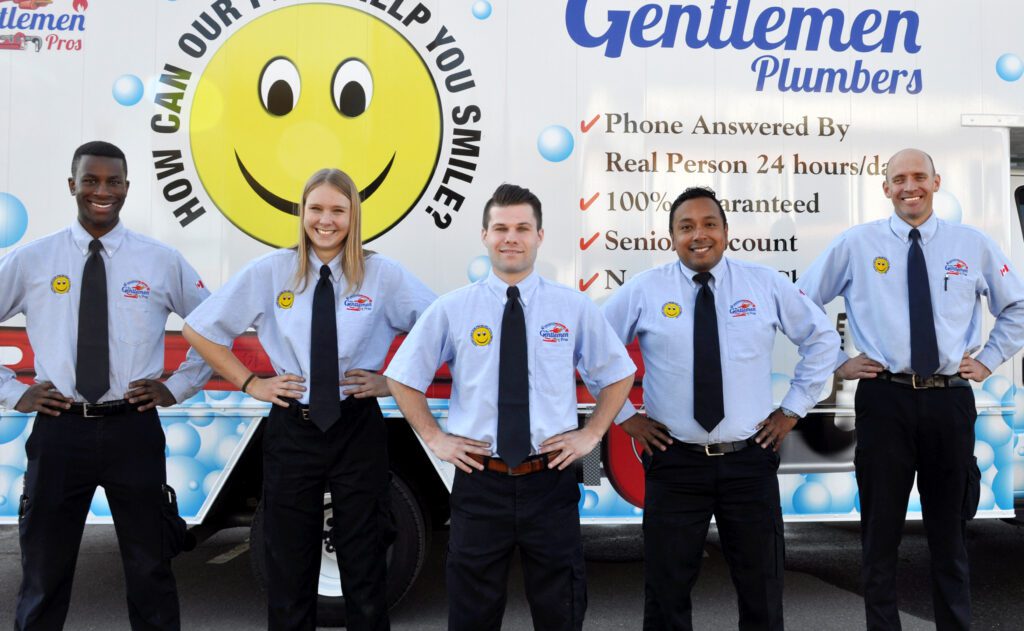
Same Day Service
Since 1992
Call The Gentleman Pros Now!
(587) 786-6328

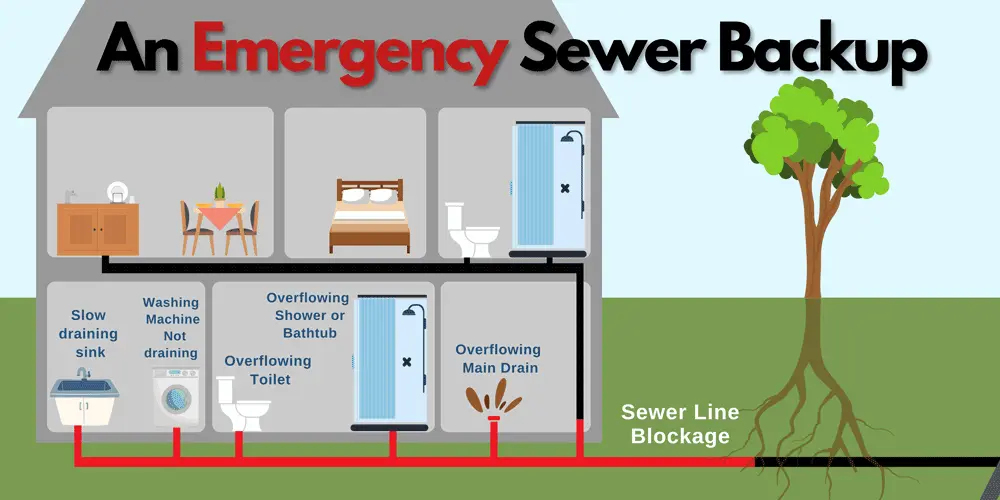
Is your sewer backed up? Is sewage 💩 water flowing back into your tub, shower, or basement?
Is this a recurring problem?
We know what you are thinking … *#%^&%* … and feeling… 😳😡😭😩!
We’ve been there and want to help!
We diagnose and take care of sewer backups every day! We will help you understand what is going on and empower you to make the best decision on how to fix it.
Maybe you have tried root killers, augering, or other DIY solutions, but the sewer continues to back up. This article will explain the difference between long-term and band-aid fixes to save you time, money, and stress!
If sewage is coming back up in showers, the main cleanout, or toilets on the lowest level of your home — you have a backup.
Don’t worry! We’ll walk you through it!
If sewage is coming back up don’t:
In short, a sewer backup occurs when the flow of wastewater (from toilets, sinks, tubs, etc.) through the main sewer line to the municipal sewer line is disrupted by a clog or a break in the sewer line.
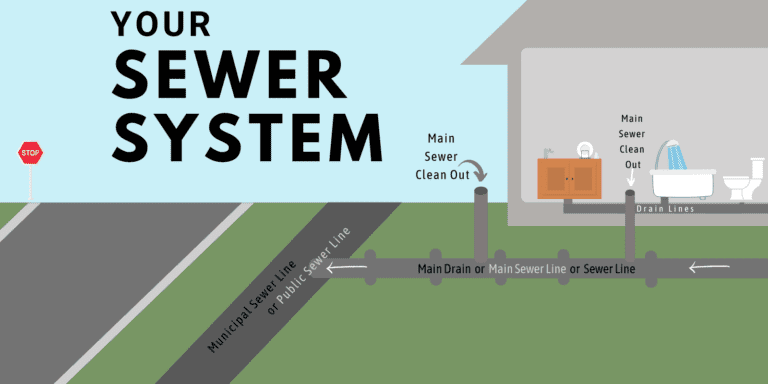
Unfortunately, early signs are easily ignored — and frankly, difficult to recognize.
So don’t be too hard on yourself!
Early signs may be slow-draining sinks, tubs, and toilets on the lowest level of your home. By the time this happens, you could be just one flush away from a major backup.
To prevent a major backup, we recommend an annual camera inspection of your main sewer line. This is the only way to know for certain that you have a problem or you will have a problem in the future.
We will cover why camera inspections are so important in the next section, “What Causes Sewer Backups?”
Don’t be confused, they are very different!
To understand the difference, let’s go through some terms.
Let’s start with drain lines. These pipes are inside your home and transport wastewater and sewage from your sinks, showers, toilets, dishwashers, and washing machines to the main sewer line. The drain lines are smaller in diameter than the main sewer line.
The main sewer line — often called the main drain or sewer line — is the large pipe that collects wastewater and sewage from your home and conveys it to the municipal sewer line. (or the septic tank in rural areas).
Municipal sewer lines, public sewer lines, or sanitary sewer lines refer to the city’s sewer pipes that carry sewage from your home’s main sewer line to the wastewater treatment facility.
Also… it is helpful to know the name of that pipe that sticks out with a lid on it in your basement or yard. It is called the sewer cleanout or main sewer cleanout. You will need access to it.
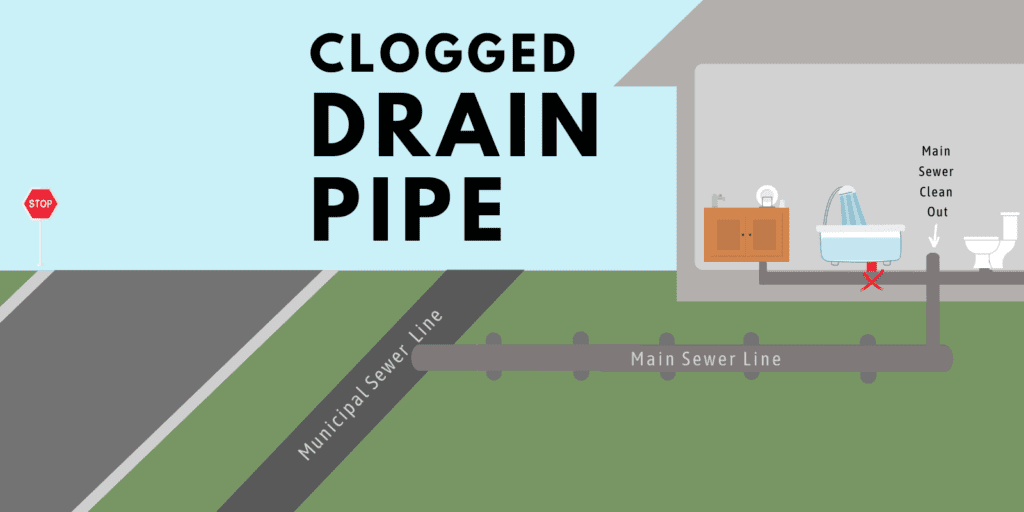
A clogged drain pipe is usually isolated to one drain pipe, so it only affects the specific fixture that is clogged.
A drain clog is usually caused by hair, soap or mineral buildup, grease, or other minor obstructions.
These small drain clogs are inconvenient, but they are minor compared to sewer line clogs.
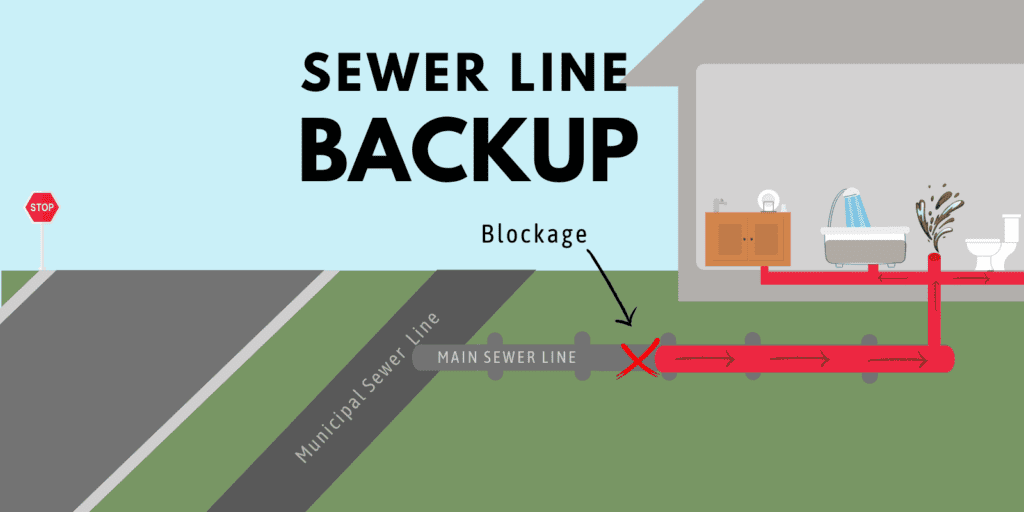
A clogged main sewer line prevents sewer water from your home from reaching the municipal line. It causes a backup because the wastewater cannot move forward, so it goes back the way it came and enters your home causing a smelly mess.
A clog in the main sewer line is a much bigger problem than a clogged drainpipe. A main sewer line clog impacts the entire plumbing system of your home.
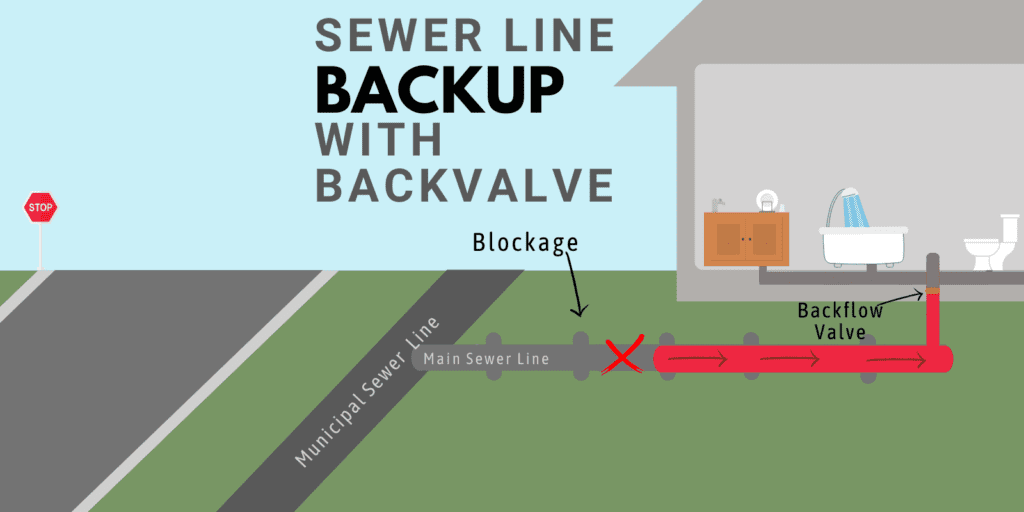
Also, a backwater valve or backflow preventer can be installed to help slow the wastewater from coming into your home if the municipal line is backing up.
If you are in the middle of cleaning up a sewer backup, we’re sorry you didn’t know before now! If you want to know all the major causes of sewer backups, keep reading.
We have investigated thousands of sewer backups. And we want to share everything we know about why backups happen.
Our ultimate goal is that you never have another sewer backup again!
In this section, we will outline the 3 main causes of sewer backups:
This is a deep dive into the main causes of sewer backups.
So let’s dive right in!
We have all been there — conveniently tossing something in the toilet that is better suited for the garbage.
The lazy convenience may not seem to disturb your plumbing — at first.
No immediate backup resulted (shrug emoji), but over time a silent clog may be forming. (Thinking Face emoji.)
If your sewer pipes are infested with roots, are damaged, or are decades old, a giant clog may form more rapidly. Flushing the wrong things in these circumstances will be more detrimental to your plumbing lines.
Healthy pipes or not, the following items should NEVER be flushed down the toilet or drains (but often are).
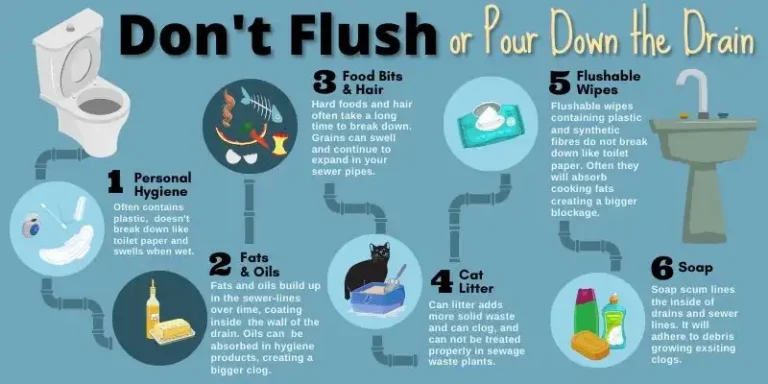
The short answer is no.
Tampons can lead to sewer line clogs that are expensive to repair.
Tampons don’t break down when they are wet. (Toilet paper for example is designed to break down when wet.) Instead, tampons swell and expand.
If an existing clog or obstruction is in your sewer line, flushing tampons will make it worse! Final words on tampon flushing — we know it’s convenient — but don’t do it!
Condoms should not be flushed, but often are.
We would never recommend flushing plastic or latex down the toilet. Latex will slowly break down over time, but latex can cause a lot of havoc on your sewer lines before it does.
The biggest issue with flushing condoms is they can catch clogs or the rough interior walls of the sewer line contributing to a blockage over time.
No, they are not! (Put this on your social media, tell everyone you know!!)
Flushable wipes are designed to have more strength than toilet paper and usually contain plastic.
They are extremely destructive, especially as they absorb grease and hold their form. They become a ticking time bomb as they create clogs and cause problems in your sewer pipes.
So-called “flushable” wipes have been the rising cause of blocked municipal sewer systems in the last decade.
Oil and grease are major clog contributors.
It’s tempting to pour liquid grease and oil down the drain. (They are so deceiving in a liquid state!)
Out of sight, out of mind and we often forget that oil and grease harden as they cool, coating the pipes and creating blockages.
Oils and fats are especially problematic when they’re absorbed by personal hygiene products like “flushable wipes” and create fatbergs.
Yes, that is a thing! Read on.
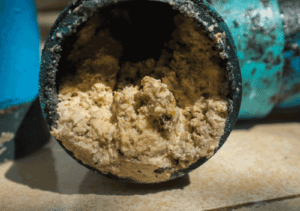
The best way to dispose of bacon grease, animal fat, or vegetable fat cooling to a solid state at room temperature, and then wipe the grease into the garbage or compost.
A fatberg is pretty much exactly what it sounds like, a compound of the words “fat” and “iceberg”.
A fatberg is a mass of congealed cooking grease and a combination of other non-biodegradable solids that gives the fat structure.
“Flushable” wipes, cotton swabs, tampons, pads, condoms, food waste, oil, and fat collect in the sewer lines and combine to form fatbergs, causing major clogs in sewer lines — yuck!
Fatbergs have been found in city sewer systems around the world, including London, New York, Dever, Baltimore, Liverpool, and Melbourne.
The largest fatberg was found in Liverpool, England, weighing 440 tons (400 metric tonnes) and measuring 820 feet (250 meters) long.
If you are visiting London, check out The Museum of London’s exhibit featuring two pieces of fatbergs.
Food waste can easily clog drains. (Composting is better for the ecosystem, too. 😇)
Often the wrong foods are put down the drain or garbage disposal.
Eventually, this can cause or contribute to clogs and backups.
Sewer clogs don’t form overnight. (Usually!)
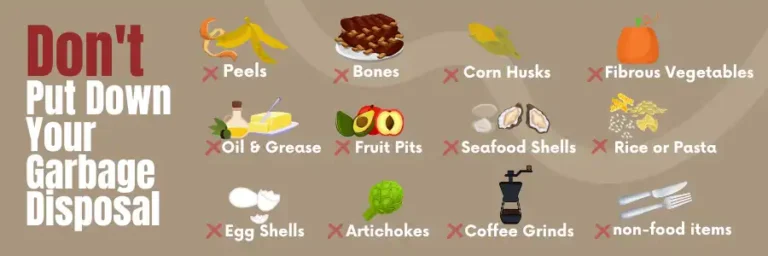
Do not put the following down the garbage disposal or drain:
You are probably thinking, my garbage disposal can cut through most of those.
It probably can but your garbage disposal is not what is in question. Even after your garbage disposal has done its job, the resulting bits of food can still cause a clog in your sewer pipes.
The following section will explain how and why food bits and other waste can get stuck in pipes.
To conclude, words to live by…

Let’s dig a little deeper.
Damaged or aged pipes can slow down or stop the flow of wastewater from your main sewer line to the municipal sewer lines.
We can’t say enough about the importance of a sewer line camera inspection! Buried sewer pipes could be silently wreaking havoc because of an unseen crack, faulty joint, pipe misalignment, collapse, or belly.
Here’s what that might look like in your sewer.
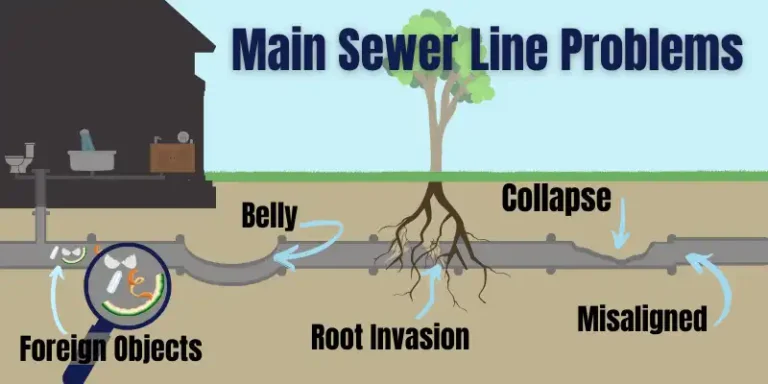
Cracks are common with older pipes. Cracks can leak wastewater and result in softening the supporting packed soil and gravel. If leaks due to cracks are unchecked in time they can loosen the packed gravel supporting the sewer pipe. Consequently, the sewer pipe can belly, or become misaligned.
(What are those? Read on — we’ll get to it.)
Cracks become more problematic when roots make their way through the cracks of the sewer line, consequently causing a sewer line backup.
Cracks are common with older pipes. Cracks can leak wastewater. This may result in softening the supporting packed soil and gravel. If leaks due to cracks are unchecked in time they can loosen the packed gravel supporting the sewer pipe. Consequently, the sewer pipe can belly, or become misaligned.
( Read more on misalignments later.)
Cracks become more problematic when roots make their way through the cracks of the sewer line, consequently causing a sewer line backup.
A pipe belly is when there’s a “sag” in the pipeline.
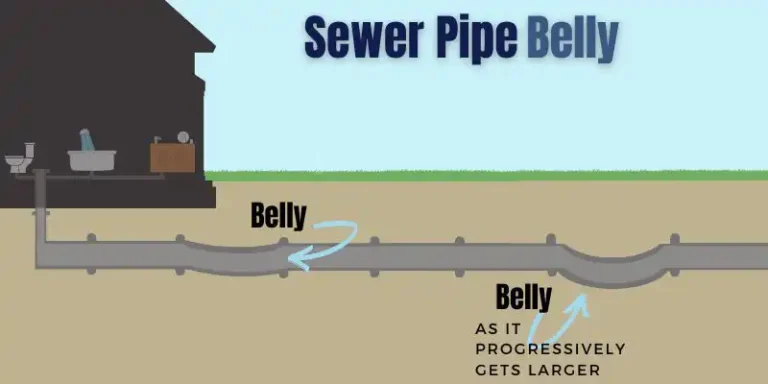
Pipe bellies occur when the ground under the pipe can no longer support the pipe. This usually happens when the ground becomes soft due to water leaking from the pipe or when the ground was not compacted properly when the pipe was installed.
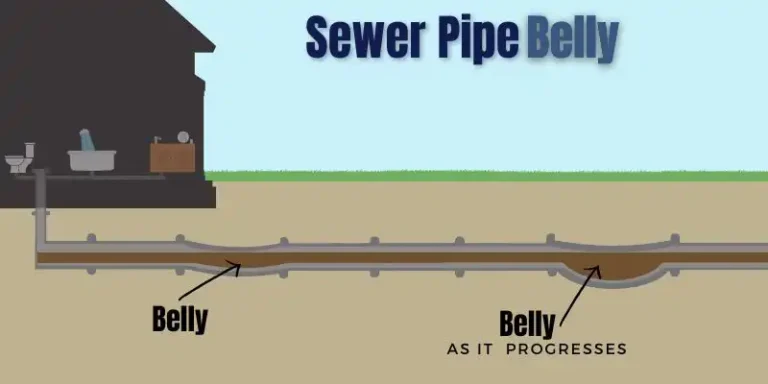
Pipe bellies catch water and waste because there isn’t enough slope in the pipe for the waste to continue travelling to the municipal sewer line. A blockage forms over time.
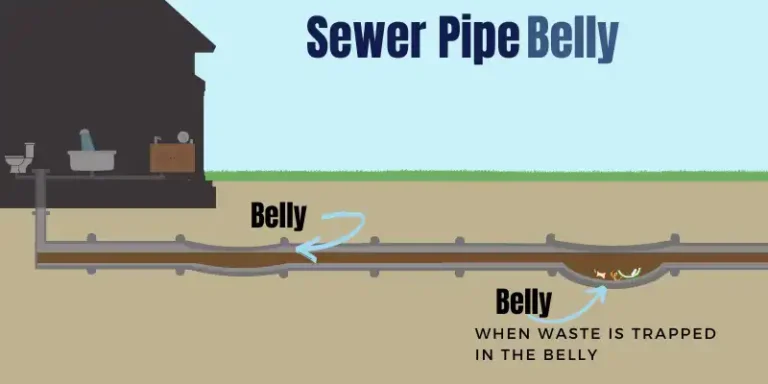
When joint seals wear down, water can leak out and in time can attract root growth or cause the sections of pipe to misalign.
Sewer pipes tend to outlive the joints connecting them.
Consequently, old sewer joints can be the cause of major backups.
This brings us to our next sewer pipe issue.
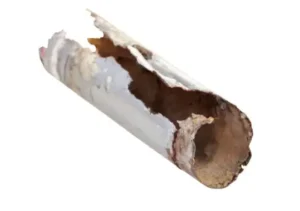
Misaligned, or offset sewer pipes are when the joints don’t properly line up. Misaligned pipes can cause major plumbing backup and problems.
Sewer pipe misalignment can be a result of the weakening of the compacted soil supporting the sewer line.
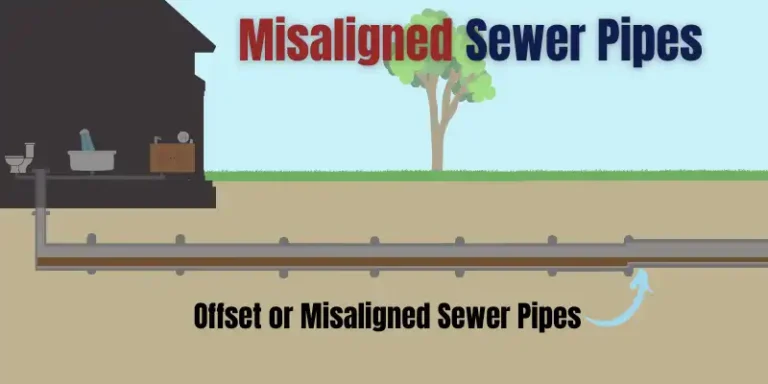
When the compacted soil softens, the pressure from the topsoil causes the pipe to misalign.
Pipe leaks can cause the ground to soften and shift, and can even wash away the compacted ground supporting the sewer pipe.
Sewer pipe misalignment can also be the result of root invasions. When the pipe joints weaken, tree roots (thirsty for water and fertilizer) can enter through the joints and grow inside the pipe. As the roots get larger, they may push the pipes until they misalign.
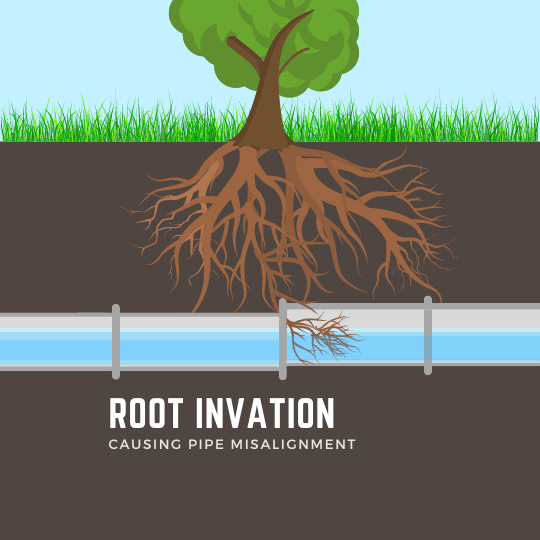
A sewer pipe collapse typically results from aged pipes, tree root invasions, or misaligned pipes.
A sewer pipe collapse is a disaster!!
Not only will your sewer line backup, but the cost to repair will also be more expensive!
Get annual camera inspections of your main sewer line, and identify a problem before your pipes collapse!!
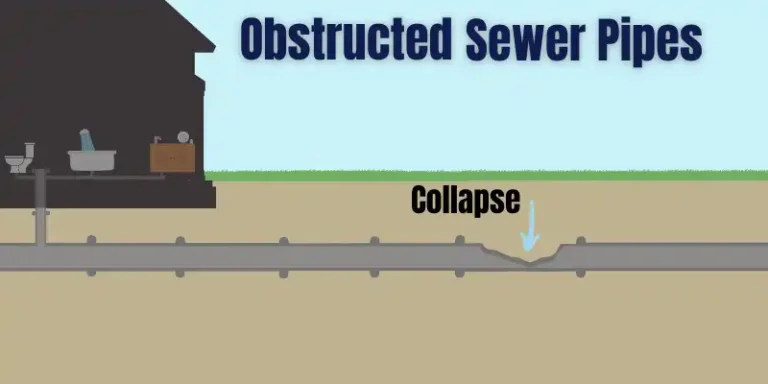
Older pipes are more prone to collapse as the pipe material and joints wear out. This is especially true for non-plastic pipes.
So you might be asking yourself, what kind of pipes do I have and how old are they?
Good questions!
In this next section we will identify different types of sewer pipes, when they were most commonly used, and which types are problematic.
Knowing when your house was built will help determine the type and age of your sewer pipes.
Each type of sewer pipe is prone to different types of issues including cracks, joint issues, pipe misalignment, pipe belly, or collapse.
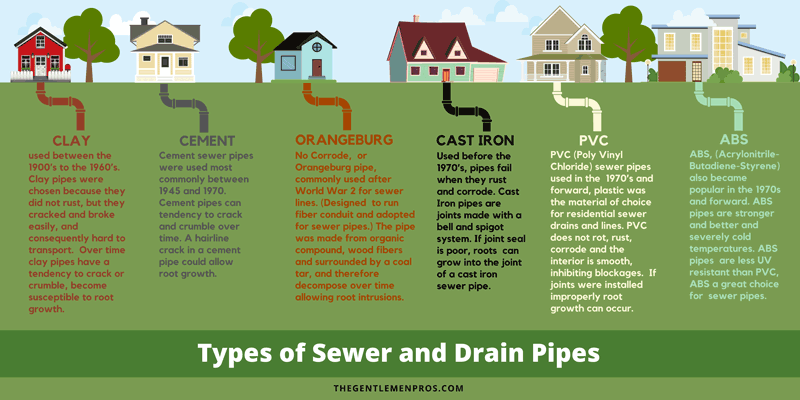
Clay sewer pipes were used commonly from the early 1900s to the 1960s, and have a typical lifespan of 50 to 60 years. Clay was the material of choice because it does not rust.
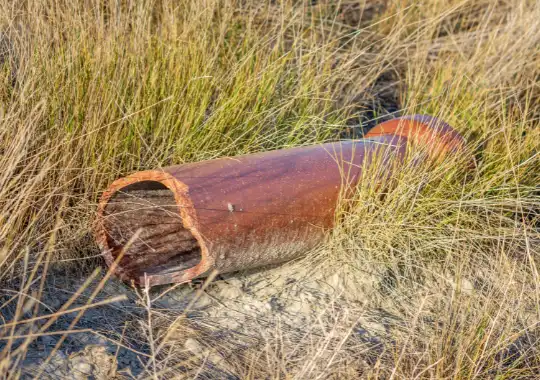
Unfortunately, clay sewer pipes tend to crack and crumble. Their joints were often made from clay putty that breaks down over time.
The most common issues with clay pipes are:
Asbestos cement sewer pipes, also known as AC pipes or transite pipes, were used most often between 1945 and 1970 in North America. They have about a 50-year lifespan.
Asbestos?!
Yes, asbestos was a common building product at that time. Before your blood pressure continues to rise as you think of all the health hazards associated with asbestos, let me remind you of something.
AC sewer pipes carry sewage water away from you, they do not bring drinking water to you.
So you can relax….sort of. 😕
AC pipes wear out, and sometimes before their projected 50-year life span. They tend to crack, crumble, and leak.
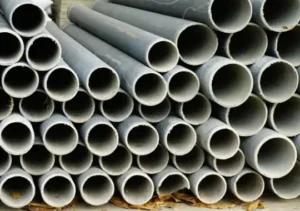
No Corrode, Orangeburg, or “black pipe” has a history of collapsing and breaking down before its projected 50-year life span. The pipe often flattens at 30 years.
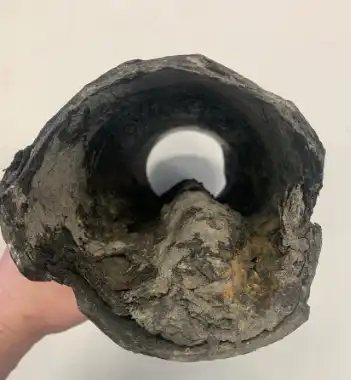
Described as a “coal tar impregnated toilet paper tube”, No Corrode pipe was commonly used across Canada and the United States after WWII until the 1970s.
No-Corrode pipe or Orangeburg pipe (named after the manufacturer) was made from wood fibres and impregnated with coal tar.
This sewer pipe is a nightmare!
Over time the pipe becomes “soggy”, causing the pipe to collapse.
Because the pipe is made with organic compounds, wood fibre and tar, and is flowing with fertilizer (sewer water) it is a prime target for root invasions.
Cast iron sewer pipes were commonly used in the earliest plumbing systems in the 1900s up until the 1970s.
They fail when they rust or when the joint seals break.
Interior corrosion causes rough surfaces on the inside of the pipes that catch waste and debris forming buildups… (This is another circumstance when flushing the wrong things can be especially harmful.)
Cast iron pipes will all rust from the outside when there is a high concentration of sodium in the soil.
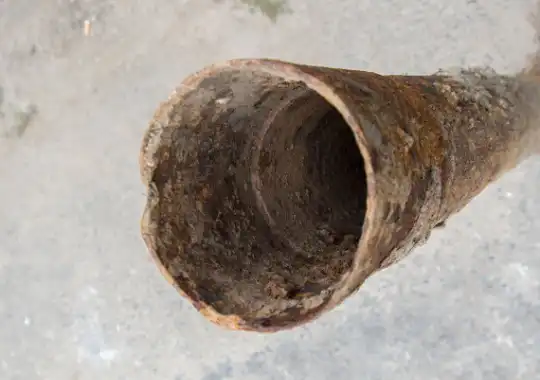
Cast iron pipes were joined using the bell and spigot system. Over time the seals on the joints will deteriorate.
When joint seals break sewer pipes leak and are susceptible to root intrusions, bellies, and misalignments.
The material of choice for residential sewer lines since the 1970s is plastic.
Because they are made of plastic, PVC (Poly Vinyl Chloride) or ABS (Acrylonitrile-Butadiene-Styrene) pipes do not rot, rust, or corrode.
These pipes’ interiors are smooth, meaning food waste and debris can’t catch on them, limiting the chances a clog will form.
PVC pipes are less likely to crack as the soil sets or moves and are slightly more flexible than ABS.
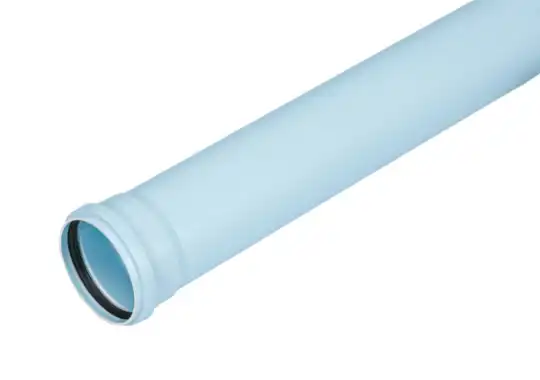
ABS) pipes are stronger than PVC pipes and can withstand severely cold temperatures, making them ideal for cold long winters.
Issues with PVC and ABS pipes are rare and they are less likely to fail compared to other pipes. They have a life expectancy of 100 years.
Issues with PVC or ABS pipes are rare compared to older pipes.
Root intrusion in PVC (and ABS) pipes typically only occurs if the joints are not installed properly.
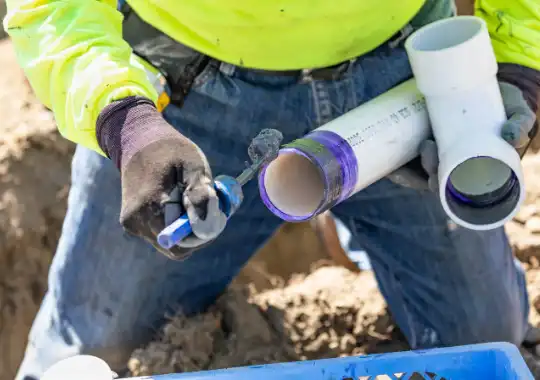
To ensure the joints are installed correctly, make sure the pipes are thoroughly and properly cleaned before the glue is applied to the joint. A tree root can get through the tiniest crack in a joint, and this tiny hair-sized root will eventually grow and become a big problem. This is why you want to make sure you have solid watertight joints.
Tree roots can also invade sewer systems through cracks, bellies, and misalignments.
Tree roots are especially problematic in older pipes. 😟
Keep reading to learn more about the problem of tree root invasions!
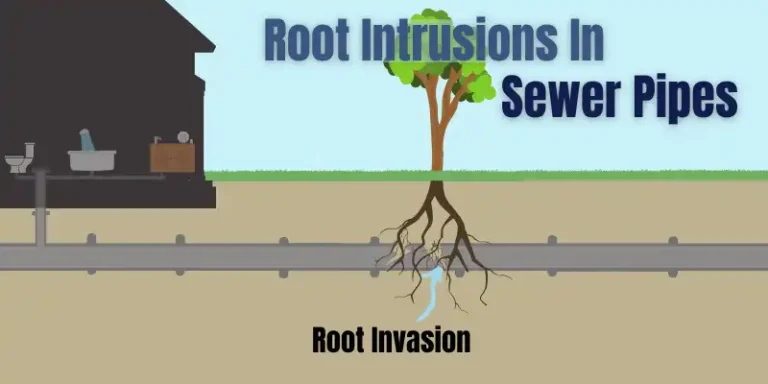
Can tree roots really cause that much damage to my sewer pipes and drains?
Yes!!
Tree roots are the number one cause of main sewer line blockages and backups, especially in older homes.
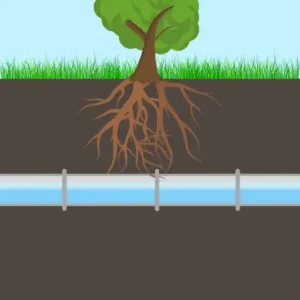
As sewer pipes age, joints typically lose their integrity before the pipes do. If sewer pipes break or wear out, even the smallest leak can encourage root growth in the pipe.
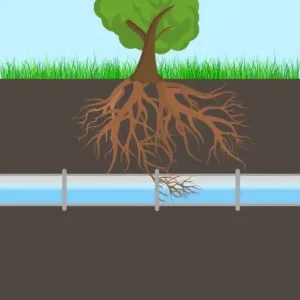
The main sewer pipe provides nutrient-rich wastewater and air, creating the ideal environment for root growth. Hair-like roots can enter through small cracks and grow into bigger tree roots, eventually creating a blockage.
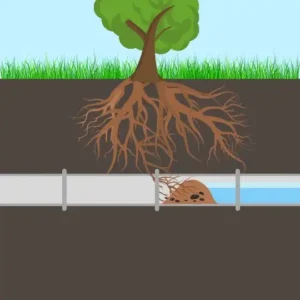
As the roots grow, they form a root ball. The root ball acts as a net and catchest toilet paper, food waste, and other debris as wastewater moves the debris through the sewer pipe.
The combination of flushing the wrong things and a root invasion in your main sewer line can be obstructive.
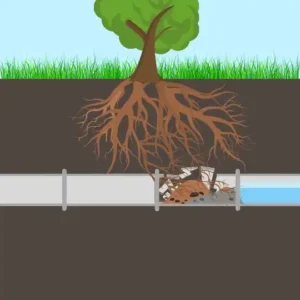
In time, as the roots grow in and around the pipe, the roots can cause further pipe damage, like a pipe misalignment.
Bottom line …
Get an annual camera inspection of your main sewer line!!!
Signs of leaks, damage, root growth, and clogs are hard to detect ahead of time and a camera inspection will help you find them before they become a big problem.
If your sewer lines are buried only a few feet deep, look for soggy patches or extra green patches of grass in your yard. These patches could indicate a leak in your sewer pipe.
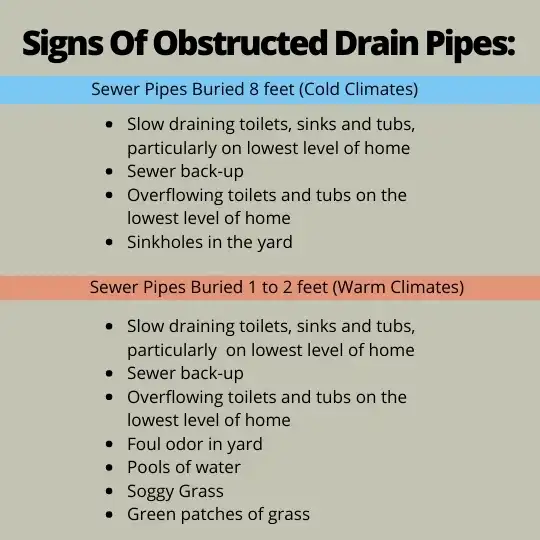
Sewer backups are a stressful, unanticipated expense!
We know what you are feeling…😡😭😩!
So, how do you clear it, and how much will it cost?
When you have an emergency sewer backup, getting your sewer free and flowing as fast as possible is critical.
Fortunately, sewer line clearing can be done by:
So good news and bad news!
Good news, augering or hydrojetting your sewer line may restore flow to your sewer faster than any other option.
They are also the less expensive solutions! 😁
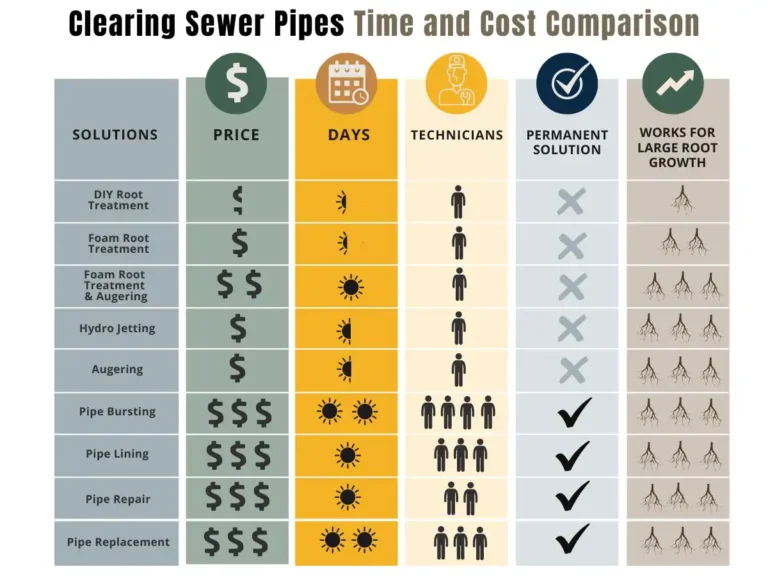
*These are estimated times and costs. Work may vary in each situation and circumstance.
The bad news, augering and hydro-jetting are temporary fixes in most cases. Most sewer backups are caused by pipe cracks, bellies, roots, and/or aging pipes.
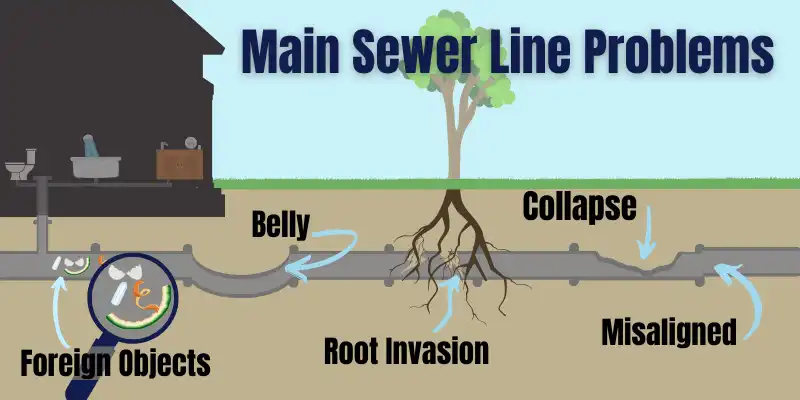
To treat the cause of a backup, not just the symptom, jump ahead to the next section and discover “Sewer Line Backup: How do I Clear My Sewer Line (for Good)? ”
You may be tempted to choose the fastest, least expensive option.
We get it! In the short term, a band-aid fix might be the right choice.

But, you will save money, stress, and time by choosing a more permanent long-term fix.
In this section, we will outline all of the “short-term” fixes.
Augering, sometimes called snaking, is ideal in emergency sewer backup situations. It is the easiest and quickest way to remove a clog and get sewers free and flowing.
The auger will drill its way into the clog allowing the waste to move through the clog.

Although augering will clear the clog, it won’t repair the cause of the problem (pipe misalignment, pipe belly, roots, etc.). [Because the pipe isn’t repaired, clogs will form again because debris will continue to get caught and roots will grow back.
Also, augering can not be done on collapsing or severely damaged sewer pipes.
Augering could cause further damage.
A sewer line camera inspection will determine if augering is a good option for removing the clog from your sewer lines.
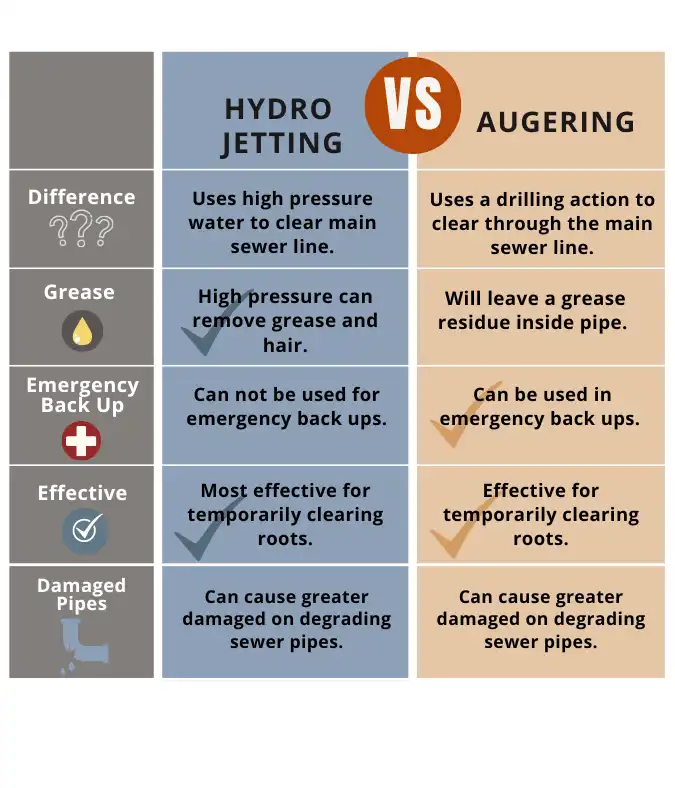
Cost: $
Time: Typically ½ day
Technicians Required: 1
Another option for clearing your sewer line is hydro-jetting.
A hydro jet is like a garden hose on steroids — it uses high volumes of water to pressure wash the inside of your sewer pipes.
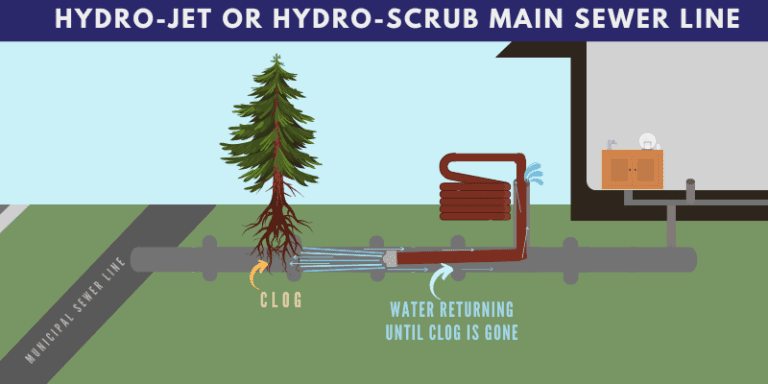
A hydro jet can clean out roots, debris, and the build-up on the interior pipe wall. It, however, is not recommended for emergency backups.
It is best suited for pipe cleaning when the main sewer line is not backed up, or if the sewer line cleanout is outside of the home.
Hydrojetting your sewer line when it’s backed up will displace large volumes of water. If you don’t have an outside clean-out (at the lowest point of your plumbing), the water will return back into your home, flooding it until the pressure breaks through the clog.
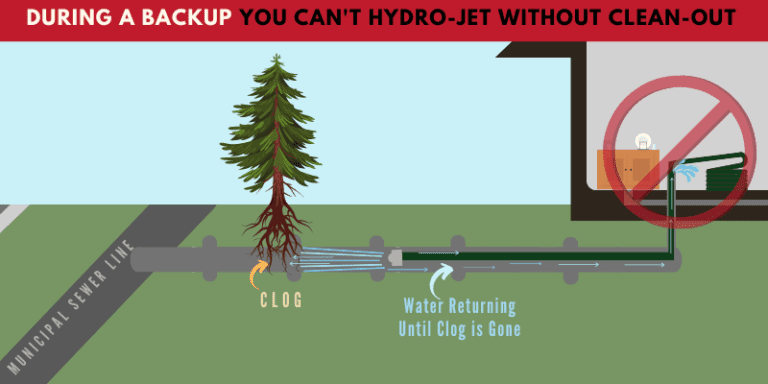
Hydro jetting is a great solution when you have an outside cleanout and it is lower than the lowest point of the plumbing in your house.
Hydro-jetting sewer pipes regularly can remove oil and scum that forms on the interior of the pipe and push through clogs caused by food bits and hygiene items.
It also clears your sewer line more thoroughly than an auger.

Hydro Jetting can keep roots at bay for a time.
It does not fix the cracks where the roots are entering your sewer pipes. The roots will grow back eventually!
The recurring cost of hydrojetting or augering may influence you to choose a permanent solution.
Cost: $
Time: Typically ½ day
Technicians Required: 1
Yes.
Chemical root killers can be an effective short-term solution for removing roots in your main sewer line.
However, the better long-term solution is always to repair the breach in the sewer line to ensure the roots can’t get back into your pipes.
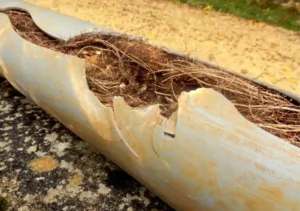
Read more about chemical using chemical root killers to clear your sewer lines.
The next section explores long-term solutions to ensure you don’t have another sewer backup!
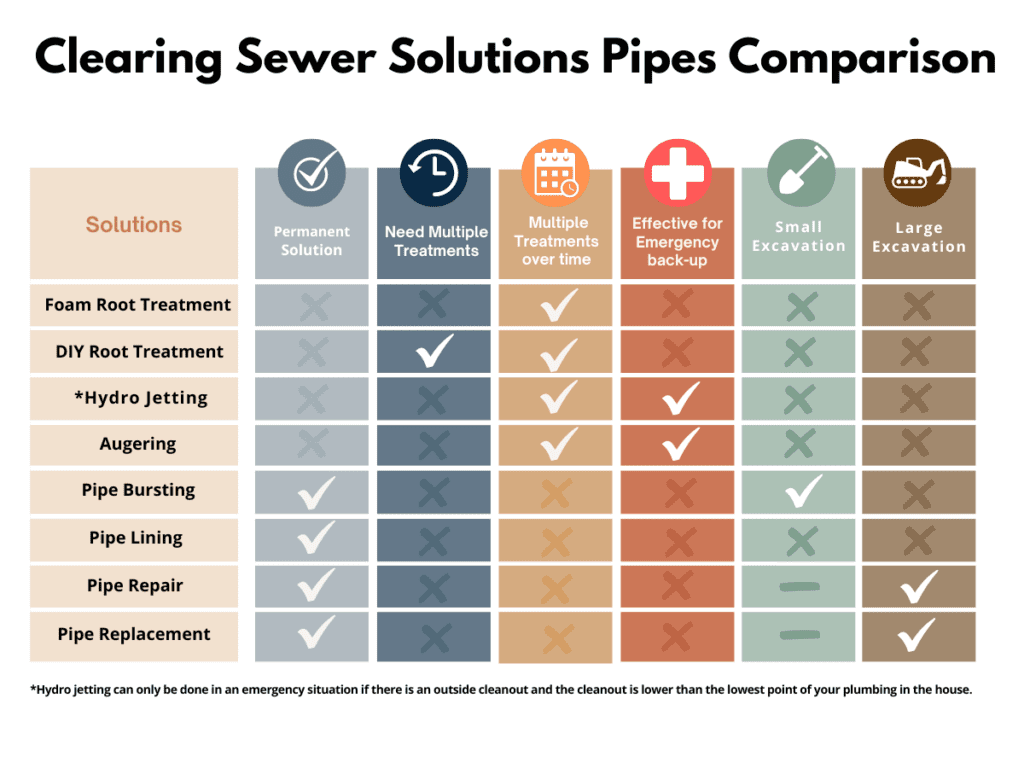
Now that you understand all the possible causes of main sewer line backups, let’s dive into long-term solutions for main sewer line backups!
Please take our advice!😉
Get a camera inspection before you decide on any solution! Know what is going on in your sewer pipes!
The following fixes are permanent solutions, not band-aid fixes!
Translation: Fix it right the first time, and you won’t have to fix it again!
Don’t worry about disgusting and costly sewer backups again! 😅
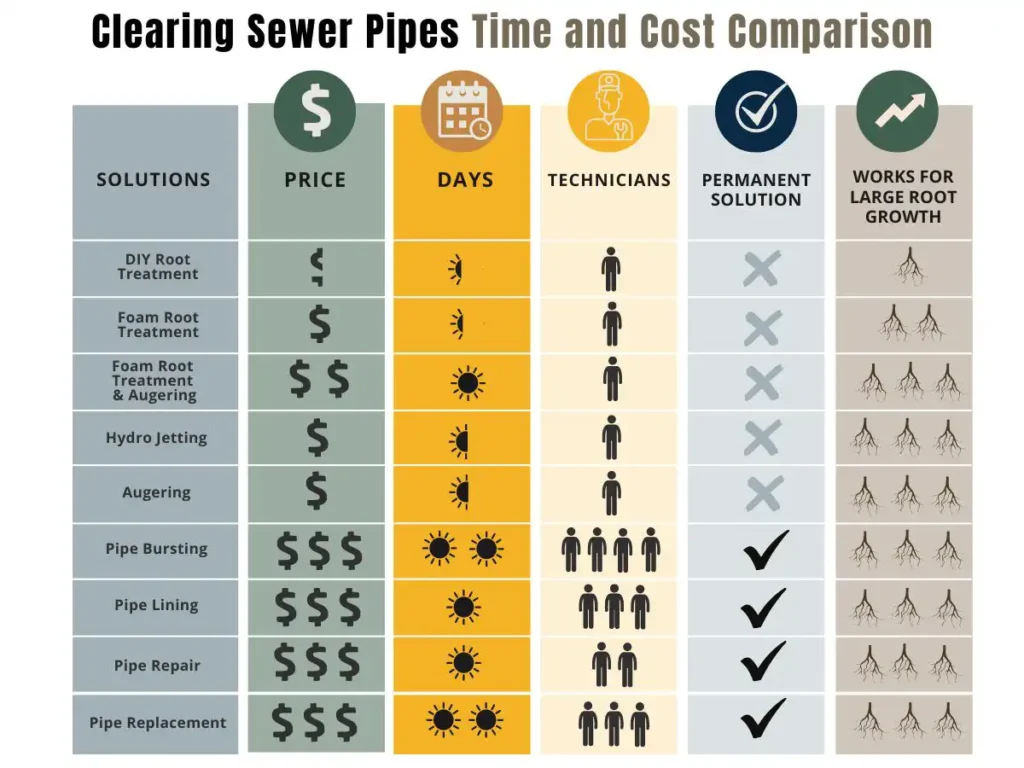
These are estimated times and costs. Work may vary in each situation and circumstance.
Cost: $$$
Time: typically 1 day
Technicians Required: 3
Pipelining (also known as Cured-In-Place Piping, CIPP, or trenchless pipelining) is a process where an epoxy coating is applied to the interior of the pipe wall. The epoxy hardens and creates a seamless sewer pipe with no joints.
A great benefit of this solution is very little excavation is required. No machines digging up your yard and leaving you with a big landscaping project.
Yes, this can be done! Renewing your pipes, without having to excavate!

Pipelining is an ideal solution when pipes are backed up because of root intrusions, cracks, or broken joint seals.
Pipelining can only be done if the pipes are still holding their shape and the joints are still aligned.
Pipelining is not a good solution when the main sewer lines are bellied, or misaligned, or if the pipes no longer hold their shape.
This is a less expensive option than excavating, but if you wait too long it may not be a viable solution.
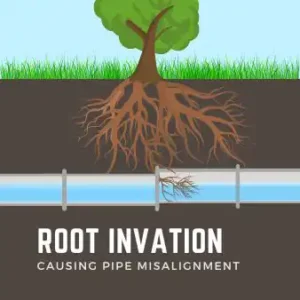
For example, a small joint leak left unchecked turns into a pipe misalignment. And once the pipes are misaligned, pipelining is no longer an option.
Another thing to consider is with pipelining there are no hidden costs associated with excavation.
The cost to re-landscape or rebuild structures on your property that must be removed when excavating can be pricey.

Pipelining creates a continuous pipe with no joints. Why does that matter?
Joints are usually the first thing to go in the life of a sewer pipe, so creating a pipe that doesn’t have any is pretty awesome!
Cost: $$$
Time: typically 2 days
Technicians Required: 4
Pipe bursting, or trenchless pipe bursting, is a permanent solution to pipe breaches in sewer pipes. Pipe bursting is less destructive than digging up damaged sewer pipes.

Pipe bursting is a trenchless procedure that creates a new pipe while simultaneously breaking apart the old sewer pipe.
A pipe bursting head is hydraulically pulled underground to burst the pipe and bring a new pipe into its place.
Pipe bursting will end sewer back-ups that are caused by root infestations or damaged or degrading pipes.
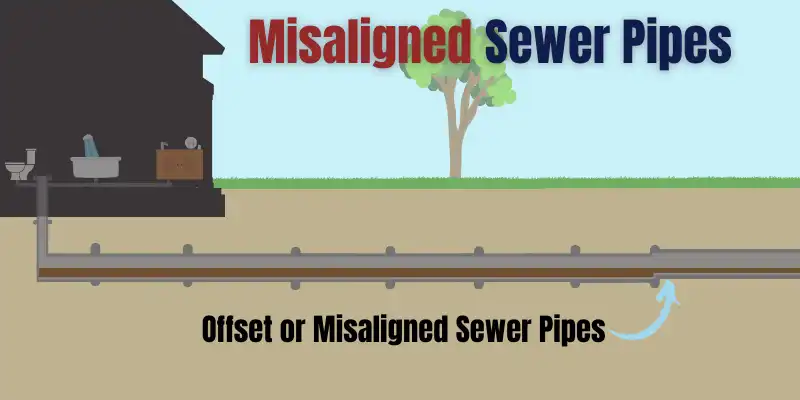
Unlike pipelining, which is only ideal when sewer pipes are holding a healthy shape, pipe bursting can often be a solution when pipes are backing up due to misalignment, or when the pipe is misshapen.
Pipe bursting saves money when sewer lines run underneath driveways or decks. This avoids the further cost of not only excavating but also demolition and reconstruction costs.

The last solutions are full pipe replacement and partial pipe replacement.
Cost: $$$
Time: typically 1 day
Technicians Required:2
A partial or full pipe replacement requires you to dig up the old pipe (or section of pipe) and replace it with a new pipe.
It is ideal when root growth is due to damage or a root intrusion in a joint that isn’t water tight.

But, when is a partial sewer replacement ideal?
It is ideal if the problem is isolated to a section of pipe.
A full pipe replacement is often the better solution when pipes are past their life span regardless if the problem is currently contained to one section of pipe. When a problem occurs in one section of the pipe due to old pipes, there is a very good chance that you will soon have problems in other sections of the pipe. So you may as well do it all at once.
Problems associated with aging pipes are interior corrosion, cracks, and broken joint seals. All of which can cause backups…
We are trying to save you money!
Please consider everything before you move forward. (Including the cost to go back and refix another portion of your sewer pipe!)
Don’t cut corners, do it right the first time.

When a sewer pipe comes to the end of its life, back-ups are common.
Pipe replacement is a long-term solution that will ensure no recurring tree root infestation in the sewer line.
Cost: $$$
Time: typically 2 days
Technicians Required: 3
That question is answered best with a camera inspection that will reveal what is going on with your sewer pipes.

You will need to carefully consider the following variables to determine if this is the right solution.
How deep are the sewer pipes buried?
Lorem ipsum dolor sit amet, consectetur adipiscing elit. Ut elit tellus, luctus nec ullamcorper mattis, pulvinar dapibus leo.
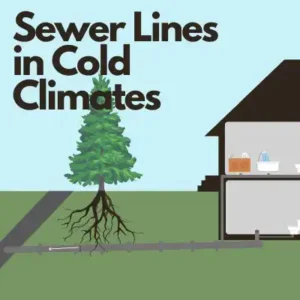
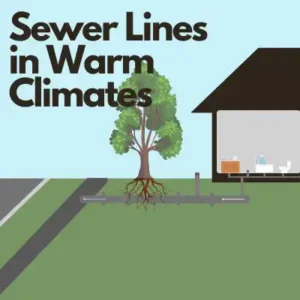
Excavation is required to get to the impacted pipes. In colder climates, the pipes are often more than 8 feet deep which is a lot of digging. Once the pipes are replaced, the soil will need to be replaced and packed, and landscaping will need to be done.
Where is the sewer pipe breach?
If the pipes are crumbling or cracked in one specific location, and root growth is isolated to one area, a partial replacement may be sufficient.
But in many situations, if the sewer line has passed its life expectancy a full replacement is a better option.
Where do the sewer lines run on the property?

Using a camera inside your sewer line, a plumbing technician can determine exactly where your sewer lines run through your property.
If sewer lines run beneath a deck or patio, more time and costs are required. You will need to demolish and then rebuild the outdoor structures adding additional expenses. Where permissible, pipelining or pipe bursting might be a better option if lines run beneath outdoor structures.
You now know the various causes of sewer backups and how to fix them. Before deciding on a solution, we strongly recommend you get a sewer line camera inspection. This will help you identify what the exact problem is and help you select a solution that solves your problem and fits your budget. Like with everything in life, there are trade-offs. Often the less expensive solutions are not long-term fixes and you will eventually need to put more — sometimes a lot more — money into the problem. Other fixes may permanently fix your problem, but they are outside your budget. Using the information in this article, you will be able to confidently decide what is best for you and your family.

Is your sewer backed up? Is sewage 💩 water flowing back into your tub, shower, or basement?
Is this a recurring problem?
We know what you are thinking … *#%^&%* … and feeling… 😳😡😭😩!
We’ve been there and want to help!
We diagnose and take care of sewer backups every day! We will help you understand what is going on and empower you to make the best decision on how to fix it.
Maybe you have tried root killers, augering, or other DIY solutions, but the sewer continues to back up. This article will explain the difference between long-term and band-aid fixes to save you time, money, and stress!
If sewage is coming back up in showers, the main cleanout, or toilets on the lowest level of your home — you have a backup.
Don’t worry! We’ll walk you through it!
If sewage is coming back up don’t:
In short, a sewer backup occurs when the flow of wastewater (from toilets, sinks, tubs, etc.) through the main sewer line to the municipal sewer line is disrupted by a clog or a break in the sewer line.

Unfortunately, early signs are easily ignored — and frankly, difficult to recognize.
So don’t be too hard on yourself!
Early signs may be slow-draining sinks, tubs, and toilets on the lowest level of your home. By the time this happens, you could be just one flush away from a major backup.
To prevent a major backup, we recommend an annual camera inspection of your main sewer line. This is the only way to know for certain that you have a problem or you will have a problem in the future.
We will cover why camera inspections are so important in the next section, “What Causes Sewer Backups?”
Don’t be confused, they are very different!
To understand the difference, let’s go through some terms.
Let’s start with drain lines. These pipes are inside your home and transport wastewater and sewage from your sinks, showers, toilets, dishwashers, and washing machines to the main sewer line. The drain lines are smaller in diameter than the main sewer line.
The main sewer line — often called the main drain or sewer line — is the large pipe that collects wastewater and sewage from your home and conveys it to the municipal sewer line. (or the septic tank in rural areas).
Municipal sewer lines, public sewer lines, or sanitary sewer lines refer to the city’s sewer pipes that carry sewage from your home’s main sewer line to the wastewater treatment facility.
Also… it is helpful to know the name of that pipe that sticks out with a lid on it in your basement or yard. It is called the sewer cleanout or main sewer cleanout. You will need access to it.

A clogged drain pipe is usually isolated to one drain pipe, so it only affects the specific fixture that is clogged.
A drain clog is usually caused by hair, soap or mineral buildup, grease, or other minor obstructions.
These small drain clogs are inconvenient, but they are minor compared to sewer line clogs.

A clogged main sewer line prevents sewer water from your home from reaching the municipal line. It causes a backup because the wastewater cannot move forward, so it goes back the way it came and enters your home causing a smelly mess.
A clog in the main sewer line is a much bigger problem than a clogged drainpipe. A main sewer line clog impacts the entire plumbing system of your home.

Also, a backwater valve or backflow preventer can be installed to help slow the wastewater from coming into your home if the municipal line is backing up.
If you are in the middle of cleaning up a sewer backup, we’re sorry you didn’t know before now! If you want to know all the major causes of sewer backups, keep reading.
We have investigated thousands of sewer backups. And we want to share everything we know about why backups happen.
Our ultimate goal is that you never have another sewer backup again!
In this section, we will outline the 3 main causes of sewer backups:
This is a deep dive into the main causes of sewer backups.
So let’s dive right in!
We have all been there — conveniently tossing something in the toilet that is better suited for the garbage.
The lazy convenience may not seem to disturb your plumbing — at first.
No immediate backup resulted (shrug emoji), but over time a silent clog may be forming. (Thinking Face emoji.)
If your sewer pipes are infested with roots, are damaged, or are decades old, a giant clog may form more rapidly. Flushing the wrong things in these circumstances will be more detrimental to your plumbing lines.
Healthy pipes or not, the following items should NEVER be flushed down the toilet or drains (but often are).

The short answer is no.
Tampons can lead to sewer line clogs that are expensive to repair.
Tampons don’t break down when they are wet. (Toilet paper for example is designed to break down when wet.) Instead, tampons swell and expand.
If an existing clog or obstruction is in your sewer line, flushing tampons will make it worse! Final words on tampon flushing — we know it’s convenient — but don’t do it!
Condoms should not be flushed, but often are.
We would never recommend flushing plastic or latex down the toilet. Latex will slowly break down over time, but latex can cause a lot of havoc on your sewer lines before it does.
The biggest issue with flushing condoms is they can catch clogs or the rough interior walls of the sewer line contributing to a blockage over time.
No, they are not! (Put this on your social media, tell everyone you know!!)
Flushable wipes are designed to have more strength than toilet paper and usually contain plastic.
They are extremely destructive, especially as they absorb grease and hold their form. They become a ticking time bomb as they create clogs and cause problems in your sewer pipes.
So-called “flushable” wipes have been the rising cause of blocked municipal sewer systems in the last decade.
Oil and grease are major clog contributors.
It’s tempting to pour liquid grease and oil down the drain. (They are so deceiving in a liquid state!)
Out of sight, out of mind and we often forget that oil and grease harden as they cool, coating the pipes and creating blockages.
Oils and fats are especially problematic when they’re absorbed by personal hygiene products like “flushable wipes” and create fatbergs.
Yes, that is a thing! Read on.

The best way to dispose of bacon grease, animal fat, or vegetable fat cooling to a solid state at room temperature, and then wipe the grease into the garbage or compost.
A fatberg is pretty much exactly what it sounds like, a compound of the words “fat” and “iceberg”.
A fatberg is a mass of congealed cooking grease and a combination of other non-biodegradable solids that gives the fat structure.
“Flushable” wipes, cotton swabs, tampons, pads, condoms, food waste, oil, and fat collect in the sewer lines and combine to form fatbergs, causing major clogs in sewer lines — yuck!
Fatbergs have been found in city sewer systems around the world, including London, New York, Dever, Baltimore, Liverpool, and Melbourne.
The largest fatberg was found in Liverpool, England, weighing 440 tons (400 metric tonnes) and measuring 820 feet (250 meters) long.
If you are visiting London, check out The Museum of London’s exhibit featuring two pieces of fatbergs.
Food waste can easily clog drains. (Composting is better for the ecosystem, too. 😇)
Often the wrong foods are put down the drain or garbage disposal.
Eventually, this can cause or contribute to clogs and backups.
Sewer clogs don’t form overnight. (Usually!)

Do not put the following down the garbage disposal or drain:
You are probably thinking, my garbage disposal can cut through most of those.
It probably can but your garbage disposal is not what is in question. Even after your garbage disposal has done its job, the resulting bits of food can still cause a clog in your sewer pipes.
The following section will explain how and why food bits and other waste can get stuck in pipes.
To conclude, words to live by…

Let’s dig a little deeper.
Damaged or aged pipes can slow down or stop the flow of wastewater from your main sewer line to the municipal sewer lines.
We can’t say enough about the importance of a sewer line camera inspection! Buried sewer pipes could be silently wreaking havoc because of an unseen crack, faulty joint, pipe misalignment, collapse, or belly.
Here’s what that might look like in your sewer.

Cracks are common with older pipes. Cracks can leak wastewater and result in softening the supporting packed soil and gravel. If leaks due to cracks are unchecked in time they can loosen the packed gravel supporting the sewer pipe. Consequently, the sewer pipe can belly, or become misaligned.
(What are those? Read on — we’ll get to it.)
Cracks become more problematic when roots make their way through the cracks of the sewer line, consequently causing a sewer line backup.
Cracks are common with older pipes. Cracks can leak wastewater. This may result in softening the supporting packed soil and gravel. If leaks due to cracks are unchecked in time they can loosen the packed gravel supporting the sewer pipe. Consequently, the sewer pipe can belly, or become misaligned.
( Read more on misalignments later.)
Cracks become more problematic when roots make their way through the cracks of the sewer line, consequently causing a sewer line backup.
A pipe belly is when there’s a “sag” in the pipeline.

Pipe bellies occur when the ground under the pipe can no longer support the pipe. This usually happens when the ground becomes soft due to water leaking from the pipe or when the ground was not compacted properly when the pipe was installed.

Pipe bellies catch water and waste because there isn’t enough slope in the pipe for the waste to continue travelling to the municipal sewer line. A blockage forms over time.

When joint seals wear down, water can leak out and in time can attract root growth or cause the sections of pipe to misalign.
Sewer pipes tend to outlive the joints connecting them.
Consequently, old sewer joints can be the cause of major backups.
This brings us to our next sewer pipe issue.

Misaligned, or offset sewer pipes are when the joints don’t properly line up. Misaligned pipes can cause major plumbing backup and problems.
Sewer pipe misalignment can be a result of the weakening of the compacted soil supporting the sewer line.

When the compacted soil softens, the pressure from the topsoil causes the pipe to misalign.
Pipe leaks can cause the ground to soften and shift, and can even wash away the compacted ground supporting the sewer pipe.
Sewer pipe misalignment can also be the result of root invasions. When the pipe joints weaken, tree roots (thirsty for water and fertilizer) can enter through the joints and grow inside the pipe. As the roots get larger, they may push the pipes until they misalign.

A sewer pipe collapse typically results from aged pipes, tree root invasions, or misaligned pipes.
A sewer pipe collapse is a disaster!!
Not only will your sewer line backup, but the cost to repair will also be more expensive!
Get annual camera inspections of your main sewer line, and identify a problem before your pipes collapse!!

Older pipes are more prone to collapse as the pipe material and joints wear out. This is especially true for non-plastic pipes.
So you might be asking yourself, what kind of pipes do I have and how old are they?
Good questions!
In this next section we will identify different types of sewer pipes, when they were most commonly used, and which types are problematic.
Knowing when your house was built will help determine the type and age of your sewer pipes.
Each type of sewer pipe is prone to different types of issues including cracks, joint issues, pipe misalignment, pipe belly, or collapse.

Clay sewer pipes were used commonly from the early 1900s to the 1960s, and have a typical lifespan of 50 to 60 years. Clay was the material of choice because it does not rust.

Unfortunately, clay sewer pipes tend to crack and crumble. Their joints were often made from clay putty that breaks down over time.
The most common issues with clay pipes are:
Asbestos cement sewer pipes, also known as AC pipes or transite pipes, were used most often between 1945 and 1970 in North America. They have about a 50-year lifespan.
Asbestos?!
Yes, asbestos was a common building product at that time. Before your blood pressure continues to rise as you think of all the health hazards associated with asbestos, let me remind you of something.
AC sewer pipes carry sewage water away from you, they do not bring drinking water to you.
So you can relax….sort of. 😕
AC pipes wear out, and sometimes before their projected 50-year life span. They tend to crack, crumble, and leak.

No Corrode, Orangeburg, or “black pipe” has a history of collapsing and breaking down before its projected 50-year life span. The pipe often flattens at 30 years.

Described as a “coal tar impregnated toilet paper tube”, No Corrode pipe was commonly used across Canada and the United States after WWII until the 1970s.
No-Corrode pipe or Orangeburg pipe (named after the manufacturer) was made from wood fibres and impregnated with coal tar.
This sewer pipe is a nightmare!
Over time the pipe becomes “soggy”, causing the pipe to collapse.
Because the pipe is made with organic compounds, wood fibre and tar, and is flowing with fertilizer (sewer water) it is a prime target for root invasions.
Cast iron sewer pipes were commonly used in the earliest plumbing systems in the 1900s up until the 1970s.
They fail when they rust or when the joint seals break.
Interior corrosion causes rough surfaces on the inside of the pipes that catch waste and debris forming buildups… (This is another circumstance when flushing the wrong things can be especially harmful.)
Cast iron pipes will all rust from the outside when there is a high concentration of sodium in the soil.

Cast iron pipes were joined using the bell and spigot system. Over time the seals on the joints will deteriorate.
When joint seals break sewer pipes leak and are susceptible to root intrusions, bellies, and misalignments.
The material of choice for residential sewer lines since the 1970s is plastic.
Because they are made of plastic, PVC (Poly Vinyl Chloride) or ABS (Acrylonitrile-Butadiene-Styrene) pipes do not rot, rust, or corrode.
These pipes’ interiors are smooth, meaning food waste and debris can’t catch on them, limiting the chances a clog will form.
PVC pipes are less likely to crack as the soil sets or moves and are slightly more flexible than ABS.

ABS) pipes are stronger than PVC pipes and can withstand severely cold temperatures, making them ideal for cold long winters.
Issues with PVC and ABS pipes are rare and they are less likely to fail compared to other pipes. They have a life expectancy of 100 years.
Issues with PVC or ABS pipes are rare compared to older pipes.
Root intrusion in PVC (and ABS) pipes typically only occurs if the joints are not installed properly.

To ensure the joints are installed correctly, make sure the pipes are thoroughly and properly cleaned before the glue is applied to the joint. A tree root can get through the tiniest crack in a joint, and this tiny hair-sized root will eventually grow and become a big problem. This is why you want to make sure you have solid watertight joints.
Tree roots can also invade sewer systems through cracks, bellies, and misalignments.
Tree roots are especially problematic in older pipes. 😟
Keep reading to learn more about the problem of tree root invasions!

Can tree roots really cause that much damage to my sewer pipes and drains?
Yes!!
Tree roots are the number one cause of main sewer line blockages and backups, especially in older homes.

As sewer pipes age, joints typically lose their integrity before the pipes do. If sewer pipes break or wear out, even the smallest leak can encourage root growth in the pipe.

The main sewer pipe provides nutrient-rich wastewater and air, creating the ideal environment for root growth. Hair-like roots can enter through small cracks and grow into bigger tree roots, eventually creating a blockage.

As the roots grow, they form a root ball. The root ball acts as a net and catchest toilet paper, food waste, and other debris as wastewater moves the debris through the sewer pipe.
The combination of flushing the wrong things and a root invasion in your main sewer line can be obstructive.

In time, as the roots grow in and around the pipe, the roots can cause further pipe damage, like a pipe misalignment.
Bottom line …
Get an annual camera inspection of your main sewer line!!!
Signs of leaks, damage, root growth, and clogs are hard to detect ahead of time and a camera inspection will help you find them before they become a big problem.
If your sewer lines are buried only a few feet deep, look for soggy patches or extra green patches of grass in your yard. These patches could indicate a leak in your sewer pipe.

Sewer backups are a stressful, unanticipated expense!
We know what you are feeling…😡😭😩!
So, how do you clear it, and how much will it cost?
When you have an emergency sewer backup, getting your sewer free and flowing as fast as possible is critical.
Fortunately, sewer line clearing can be done by:
So good news and bad news!
Good news, augering or hydrojetting your sewer line may restore flow to your sewer faster than any other option.
They are also the less expensive solutions! 😁

*These are estimated times and costs. Work may vary in each situation and circumstance.
The bad news, augering and hydro-jetting are temporary fixes in most cases. Most sewer backups are caused by pipe cracks, bellies, roots, and/or aging pipes.

To treat the cause of a backup, not just the symptom, jump ahead to the next section and discover “Sewer Line Backup: How do I Clear My Sewer Line (for Good)? ”
You may be tempted to choose the fastest, least expensive option.
We get it! In the short term, a band-aid fix might be the right choice.

But, you will save money, stress, and time by choosing a more permanent long-term fix.
In this section, we will outline all of the “short-term” fixes.
Augering, sometimes called snaking, is ideal in emergency sewer backup situations. It is the easiest and quickest way to remove a clog and get sewers free and flowing.
The auger will drill its way into the clog allowing the waste to move through the clog.

Although augering will clear the clog, it won’t repair the cause of the problem (pipe misalignment, pipe belly, roots, etc.). [Because the pipe isn’t repaired, clogs will form again because debris will continue to get caught and roots will grow back.
Also, augering can not be done on collapsing or severely damaged sewer pipes.
Augering could cause further damage.
A sewer line camera inspection will determine if augering is a good option for removing the clog from your sewer lines.

Cost: $
Time: Typically ½ day
Technicians Required: 1
Another option for clearing your sewer line is hydro-jetting.
A hydro jet is like a garden hose on steroids — it uses high volumes of water to pressure wash the inside of your sewer pipes.

A hydro jet can clean out roots, debris, and the build-up on the interior pipe wall. It, however, is not recommended for emergency backups.
It is best suited for pipe cleaning when the main sewer line is not backed up, or if the sewer line cleanout is outside of the home.
Hydrojetting your sewer line when it’s backed up will displace large volumes of water. If you don’t have an outside clean-out (at the lowest point of your plumbing), the water will return back into your home, flooding it until the pressure breaks through the clog.

Hydro jetting is a great solution when you have an outside cleanout and it is lower than the lowest point of the plumbing in your house.
Hydro-jetting sewer pipes regularly can remove oil and scum that forms on the interior of the pipe and push through clogs caused by food bits and hygiene items.
It also clears your sewer line more thoroughly than an auger.

Hydro Jetting can keep roots at bay for a time.
It does not fix the cracks where the roots are entering your sewer pipes. The roots will grow back eventually!
The recurring cost of hydrojetting or augering may influence you to choose a permanent solution.
Cost: $
Time: Typically ½ day
Technicians Required: 1
Yes.
Chemical root killers can be an effective short-term solution for removing roots in your main sewer line.
However, the better long-term solution is always to repair the breach in the sewer line to ensure the roots can’t get back into your pipes.

Read more about chemical using chemical root killers to clear your sewer lines.
The next section explores long-term solutions to ensure you don’t have another sewer backup!

Now that you understand all the possible causes of main sewer line backups, let’s dive into long-term solutions for main sewer line backups!
Please take our advice!😉
Get a camera inspection before you decide on any solution! Know what is going on in your sewer pipes!
The following fixes are permanent solutions, not band-aid fixes!
Translation: Fix it right the first time, and you won’t have to fix it again!
Don’t worry about disgusting and costly sewer backups again! 😅

These are estimated times and costs. Work may vary in each situation and circumstance.
Cost: $$$
Time: typically 1 day
Technicians Required: 3
Pipelining (also known as Cured-In-Place Piping, CIPP, or trenchless pipelining) is a process where an epoxy coating is applied to the interior of the pipe wall. The epoxy hardens and creates a seamless sewer pipe with no joints.
A great benefit of this solution is very little excavation is required. No machines digging up your yard and leaving you with a big landscaping project.
Yes, this can be done! Renewing your pipes, without having to excavate!

Pipelining is an ideal solution when pipes are backed up because of root intrusions, cracks, or broken joint seals.
Pipelining can only be done if the pipes are still holding their shape and the joints are still aligned.
Pipelining is not a good solution when the main sewer lines are bellied, or misaligned, or if the pipes no longer hold their shape.
This is a less expensive option than excavating, but if you wait too long it may not be a viable solution.

For example, a small joint leak left unchecked turns into a pipe misalignment. And once the pipes are misaligned, pipelining is no longer an option.
Another thing to consider is with pipelining there are no hidden costs associated with excavation.
The cost to re-landscape or rebuild structures on your property that must be removed when excavating can be pricey.

Pipelining creates a continuous pipe with no joints. Why does that matter?
Joints are usually the first thing to go in the life of a sewer pipe, so creating a pipe that doesn’t have any is pretty awesome!
Cost: $$$
Time: typically 2 days
Technicians Required: 4
Pipe bursting, or trenchless pipe bursting, is a permanent solution to pipe breaches in sewer pipes. Pipe bursting is less destructive than digging up damaged sewer pipes.

Pipe bursting is a trenchless procedure that creates a new pipe while simultaneously breaking apart the old sewer pipe.
A pipe bursting head is hydraulically pulled underground to burst the pipe and bring a new pipe into its place.
Pipe bursting will end sewer back-ups that are caused by root infestations or damaged or degrading pipes.

Unlike pipelining, which is only ideal when sewer pipes are holding a healthy shape, pipe bursting can often be a solution when pipes are backing up due to misalignment, or when the pipe is misshapen.
Pipe bursting saves money when sewer lines run underneath driveways or decks. This avoids the further cost of not only excavating but also demolition and reconstruction costs.

The last solutions are full pipe replacement and partial pipe replacement.
Cost: $$$
Time: typically 1 day
Technicians Required:2
A partial or full pipe replacement requires you to dig up the old pipe (or section of pipe) and replace it with a new pipe.
It is ideal when root growth is due to damage or a root intrusion in a joint that isn’t water tight.

But, when is a partial sewer replacement ideal?
It is ideal if the problem is isolated to a section of pipe.
A full pipe replacement is often the better solution when pipes are past their life span regardless if the problem is currently contained to one section of pipe. When a problem occurs in one section of the pipe due to old pipes, there is a very good chance that you will soon have problems in other sections of the pipe. So you may as well do it all at once.
Problems associated with aging pipes are interior corrosion, cracks, and broken joint seals. All of which can cause backups…
We are trying to save you money!
Please consider everything before you move forward. (Including the cost to go back and refix another portion of your sewer pipe!)
Don’t cut corners, do it right the first time.

When a sewer pipe comes to the end of its life, back-ups are common.
Pipe replacement is a long-term solution that will ensure no recurring tree root infestation in the sewer line.
Cost: $$$
Time: typically 2 days
Technicians Required: 3
That question is answered best with a camera inspection that will reveal what is going on with your sewer pipes.

You will need to carefully consider the following variables to determine if this is the right solution.
How deep are the sewer pipes buried?
Lorem ipsum dolor sit amet, consectetur adipiscing elit. Ut elit tellus, luctus nec ullamcorper mattis, pulvinar dapibus leo.


Excavation is required to get to the impacted pipes. In colder climates, the pipes are often more than 8 feet deep which is a lot of digging. Once the pipes are replaced, the soil will need to be replaced and packed, and landscaping will need to be done.
Where is the sewer pipe breach?
If the pipes are crumbling or cracked in one specific location, and root growth is isolated to one area, a partial replacement may be sufficient.
But in many situations, if the sewer line has passed its life expectancy a full replacement is a better option.
Where do the sewer lines run on the property?

Using a camera inside your sewer line, a plumbing technician can determine exactly where your sewer lines run through your property.
If sewer lines run beneath a deck or patio, more time and costs are required. You will need to demolish and then rebuild the outdoor structures adding additional expenses. Where permissible, pipelining or pipe bursting might be a better option if lines run beneath outdoor structures.
You now know the various causes of sewer backups and how to fix them. Before deciding on a solution, we strongly recommend you get a sewer line camera inspection. This will help you identify what the exact problem is and help you select a solution that solves your problem and fits your budget. Like with everything in life, there are trade-offs. Often the less expensive solutions are not long-term fixes and you will eventually need to put more — sometimes a lot more — money into the problem. Other fixes may permanently fix your problem, but they are outside your budget. Using the information in this article, you will be able to confidently decide what is best for you and your family.
